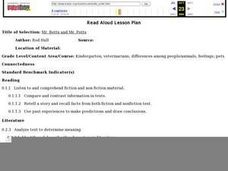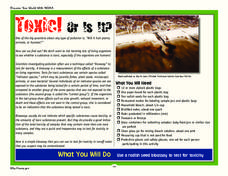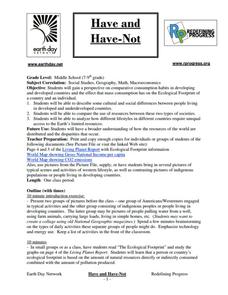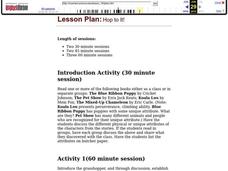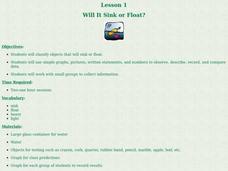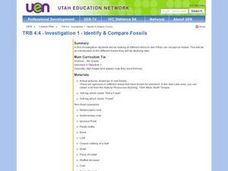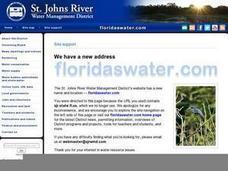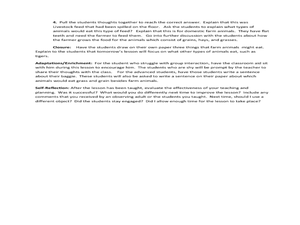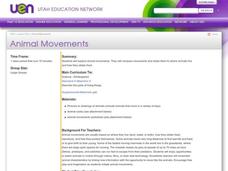Curated OER
Animal Top Trumps
Students use adjectives to construct sentences. For this english lesson, students play a card game based on Top Trumps. They use superlatives and comparatives during the game.
Curated OER
"Mr. Betts and Mr. Potts"
First graders listen to the book "Mr. Betts and Mr. Potts" and examine the career of being a veterinarian. They categorize animals based on whether they could be house pets or not, develop a class pet graph, and list the various...
Curated OER
Squid Dissection
First graders participate in dissecting a squid. They identify and locate specific parts of a squid with teacher guidance. They draw a picture of what their squid looked like and label specific parts.
Curated OER
Cell Theory, Plant And Animal Cell Comparison
Tenth graders study plant and animal cells. In this investigative activity students draw their own animal cells and label them.
NOAA
Toxic! Or Is It?
Super scientists tests the toxicity of water using radish seed bioassays. Over the course of five days, scholars observe the germination process of several radish seeds, looking closely at their roots to determine the level of toxins...
Redefining Progress
Have and Have-Not
Is there a correlation between a country's wealth and the extent of its ecological footprint? What exactly constitutes an ecological footprint, and how does one country stack up against the rest? This is a unique instructional activity...
PBS
Season Seeking
It's a time of change. A hands-on activity engages young scientists in a lesson highlighting the change of seasons. They brainstorm indicators of season changes in nature and then look for them. Next, they record observations in a field...
Curated OER
Inside the Egg, Hatching Chickens
Students conduct an egg candling activity to show the life inside a fertile egg. Students discuss the needs the egg has of the hen, as well as similarities and differences between plants and animals. Students complete a life cycle wheel...
Curated OER
Where are the Dinosaurs?
Students understand what it means when an animal is extinct. In this dinosaur lesson, students create dinosaur dioramas showing their habitat and what in their environment might make them become extinct. students pay particular attention...
Curated OER
Hop To It!
Young scholars explore grasshoppers. In this grasshoppers lesson, students measure the jumping distance of live grasshoppers. Young scholars then record the jumping distance of people in their group. Students record the...
Curated OER
Bread Cells
Fifth graders examine plant and animal cells. In this plant and animal cell instructional activity, 5th graders define what cells are, label their parts, and describe how plant and animal cells are different. They observe cells at a...
Curated OER
Will It Sink or Float?
Students perform experiments to see if items will sink or float. In this sink or float lesson, students work in groups to make predictions, and record the results. After the experiments are complete students make a book of the results.
Curated OER
What is an Ahupua'a?
Learners research ahupua'a ecosystems. In this ahupua'a lesson, students explore how land is subdivided in Hawaii and the effect on the ecosystem. Resources are provided.
Curated OER
Observing and Drawing Structures of Guppies and Goldfish
Students observe fish and focus on their structures. In this life science lesson, students work in a group and observe guppies and gold fish.
Curated OER
Investigation 1 - Identify & Compare Fossils
Fourth graders examine different items to see if they can recognize fossils. This be an introduction to the different fossils they be studying later and help them make inferences about past environments of Utah.
Curated OER
"Julie of the Wolves"
Fifth graders research life in Alaska and compare life there to their lives in this lesson. They read "Julie of the Wolves." They research through the novel and other reference books facts about the Alaskan climate and geography. They...
Curated OER
The Peaceable Kingdom
Pupils examine the life and works of Edward Hicks. Using his "Peaceable Kingdoms, they create what they believe to be their own peaceable kingdom. They compare and contrast the two kingdoms and practice layering colors with colored...
Curated OER
Lesson 6 - Our Important Wetlands and Uplands
Learners examine the benefits wetlands provide to man and nature. They compare types of wetlands in northeast or east-central Florida. They discover ways that uplands affect wetlands and water bodies.
Curated OER
Our Important Wetlands and Uplands
Students define wetlands. They list the benefits wetlans provide to man and nature. They compare types of wetlands that exist in northeast or east-central Florida. They list ways uplands affect wetlands and other water bodies.
Curated OER
What's in it and Who Eats it?
First graders explore farming by illustrating images. In this livestock lesson, 1st graders discuss what types of plants are used to feed livestock animals and how pets and humans eat the livestock animals. Students draw images of what...
Curated OER
Ecosystem Damage from Household Cleaners
Third graders assess the damage done to various ecosystems by cleaning products and discover how scientists test water quality. Using stream water and common household cleaning agents, they work in groups to test for pH levels. Once...
Curated OER
From Caterpillars to Butterflies: Life Cycles
Second graders listen to a read aloud of the Eric Carle's, The Very Hungry Caterpillar, and talk about the life cycle of caterpillars. They draw illustrations of the life cycle and compare it with the life cycle of another familiar...
Curated OER
Pio, Pio, Que Frio
Students investigate the characteristics of living things. They determine that different organisms have different needs and describe and compare them. They draw and verbally respond about their favorite animal.
Curated OER
Animal Movements
Students will explore animal movements. They will compare movements and relate them to where animals live and how they obtain food.

